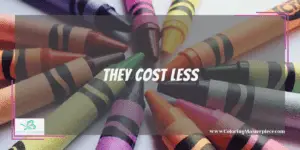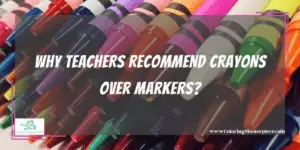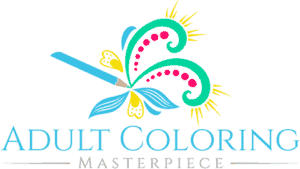It’s no secret that crayons are the OG art medium. When I think back to kindergarten art I’m greeted with the smell of wax and copy paper. I’m sure that my mom still has plenty of my crayon pages stashed away somewhere.
Crayons are better than markers because they’re easy to use and accessible for most artists. They are a more forgiving medium, which makes them fantastic for coloring and mixed media art, and the entire surface of the crayon can be used. It doesn’t matter where you are in your art journey, how old you are, or how much money you make. Crayons will always be there for you.
We know that no single medium can do it all, but crayons come pretty close. There’s a reason they’re so popular with teachers, hobby artists, and event professionals. Read on for the benefits waiting for you when you choose crayons over markers.
They Cost Less

If you look at crayons and markers, regardless of brand, odds are the crayons will be cheaper. A box of Crayolas can run you less than a dollar if you catch them at the right time of year, and plenty of artists have done fantastic work with Crayola alone.
You Can Use the Whole Crayon
Generally speaking, crayons are a stick of pigment that lacks any plastic or wooden casing (except for maybe a paper label). It’s easy to use the whole crayon in your art. You can color with both a sharpened end and a dull end for different looks and shades by using the long edge of your crayon. Even the wax shavings can be used for mixed media art by rubbing or even melting.
Layering Color
Because crayons don’t apply as wet as markers do they’re better for layering. While you will reach a point of resistance, laying different colors can yield amazing blends that are unachievable with markers.
Built-in Finish
The wax composition of crayon leaves a built-in sheen on your work and protects it from damage that time and moisture threaten. I’m sure your parents still have some crayon art of yours, even if it’s decades old, and the odds are the crayon has held up better than the paper. Unfinished marker art can be undone with a drop of water.
Etching
The wax crayon also provides a unique opportunity for you to create details using etching. This can be done using a craft knife, sharpened sticks, or even your fingernails. Meanwhile, markers are only good where they’re applied.
Resistance
Just because the wax resists other mediums doesn’t mean you can’t use them. It might be advantageous for you too. The clashing may be difficult to wrangle, but the aftermath of their struggle is often a sight to behold. Markers, which tend to play nice, don’t offer the same sort of rebellious beauty.
Graphite Crayons
Lyra has a set of grayscale crayons that offer water solubility, and I love mentioning them because of their uniqueness. While you could technically do a grayscale image using markers, the graphite look would be difficult to replicate. These are amazing for that unique style.
Everybody Has Their Flaws
Despite being popular for children and beginners, crayons have some pretty big downsides that you will need to overcome when using them.
While crayons layer much easier than markers, they do build up a resistance the more layers you have. Because of this, you may want to have a wide variety of colors, especially if using cheaper brands that are more resistant to blending. If that isn’t possible then start with light colors and build from there. (And, as always, practice blends on scrap paper.)
In regards to blending, you’ll want to do your research and trials, but a few preferred methods to look into involve using oil or heat to blend. If you can master a method of blending you will be rewarded with vibrant colors, so it’s worth looking into.
Crayons are useful in mixed media art, but they don’t always play nicely with other mediums. If you’re planning on putting anything on top of crayon you’ll need to keep this in mind. In these cases, most artists stick with acrylic paint, gesso, or Indian ink.
Why Teachers Recommend Crayons Over Markers?

Something interesting that I came across as a parent is an argument for crayons over markers from a developmental standpoint. My kids love to color with markers, and now that I think of it I’m sure they prefer them to crayons. There’s a reason for this: markers require less effort to be effective. A child knows that if they put the tip to paper it will more than likely mark.
They’re called “markers” for a reason, right? Occupational therapist Melody Cohen points this out in an article over at Playfully Learning. At this stage in a child’s life, you want them to learn more about the tools they’re using and how to use them. Cohen argues that children would be better off starting with something like a crayon.
Crayons call for more attention when applying them. There’s a greater difference in what shows up on the page depending on how hard you press them down, and it’s this kind of thing that a growing mind needs to spend time absorbing.
There are crayon brands that are built with growing bodies and brains in mind.
-
- Honeysticks: These crayons are handmade in New Zealand with 100% natural ingredients. Their beeswax composition minimizes the risk of pollution, and the crayons are safe if ingested. They have a unique shape meant for optimal grip on tiny hands.
- Crayola First Crayons: This popular brand created an even more basic set of their bestsellers. They’re a great budget buy from a trusted company, and their egg shape settles easily in a child’s palm.
Keep in mind that children under the age of six months are too young to play with crayons, and they will likely try to eat them instead. But as soon as your child shows an interest in creating art after that stage you can swoop in as a supportive (and supervising) parent.
Learn which crayons are the best HERE!
Okay, But Will I Ever Need Markers?
Don’t get me wrong: crayons are amazing, and if you look at some of the advanced work done with them you’ll be blown away. But it would be a shame to completely ignore just what markers can do for you. I guess I can play the devil’s advocate to point out a few areas where crayons may fall short.
Markers come in more varieties than crayons do, so you may find that only markers can scratch some hard-to-reach itches you have. Here are just a few ways they differ:
-
- Tips: Markers tend to define how fine a point their tipis. This can range from extra fine to bold and even jumbo sizes. Markers can even be double-sided with both a fine and bold end.
- Shapes: Bullet-pointed markers are the most popular because their rounded tip is great for both coloring and writing. You can also find chisel-tipped markers (great for calligraphy and highlighters) and brush-tipped markers (most popular with hand lettering).
- Base: While crayons are pretty much shackled to their wax base, markers tend to fall into three different categories. Alcohol-based markers dry quickly and are more permanent (as well as more odorous). Water-based markers are safer for kids, acid-free, and take longer to dry (think back to school). Solvent-based markers are used mostly for craft because they can be used on a wider array of surfaces and are nearly waterproof.
Because they’re generally considered a wet medium markers are easier to blend. This isn’t to say that it’s impossible to blend with crayons, but you’ll spend a more sizeable amount of time trying to make it work. Keep in mind that markers blend better where they meet, and not so well when layering colors on top of each other.
Markers are prone to bleeding through paper, and their wet application makes it difficult to layer colors. If crayons are not forgiving, markers are merciless when it comes to mistakes. You’ll want to plan out your work steps in advance and have a backup plan in case something goes wrong.
Frequently Asked Questions
What mediums are most similar to crayons?
The most similar medium to crayon would be wax-based colored pencils. While colored pencils are more detail-oriented than crayons, the wax-based binder will give them similar characteristics. Beyond that, you can look into pastels, but they aren’t the same.
What’s the difference between crayons and pastels?
While similar, crayons and pastels are not the same. Crayons are a medium made of wax, and pastels are made either of a dry binder or a binder of wax and oil. Because of this all three apply and can be used differently.
How can you use a white crayon?
White crayons can be used for plenty of niches, including highlighting and blending, and they’re especially useful on darker backgrounds. White crayons are a great tool for resisting artwork, especially if you don’t want to reveal too much of the base medium.
Maximize the benefits of coloring with my free adult coloring eBook and by signing up for my email newsletter HERE!
Disclaimer: The information provided by ColoringMasterpiece.com (“The Site”) is for general informational purposes only. All information on the Site is provided in good faith, however, we make no representation or warranty of any kind, express or implied, regarding the accuracy, adequacy, validity, reliability, availability, or completeness of any information on the Site. Under no circumstance shall we have any liability to you for any loss or damage of any kind incurred as a result of the use of the Site or Reliance on any information provided on the Site. Your use of the Site and your reliance on any information on the Site is solely at your own risk. This blog post is for educational purposes only and does not constitute legal advice. Please consult a legal expert to address your specific needs.
Terms and Conditions: https://coloringmasterpiece.com/terms-and-conditions/
